
Constructing Walking Jazz Bass Lines complete set. 32 % 0ff now $49.95

Book I - The blues in 12 keys & playalong
Book II - Rhythm changes in 12 keys & playalong
Book III - Standard Lines & playalong
3 book set complete with over 360 choruses of jazz walking bass lines completely written out featuring jazz standards , bebop, latin jazz, the blues in 12 keys and rhythm changes in 12 keys.
Jazz Bass Lines in 12 keys Books I - IV $70.00 FREE US shipping
Save $35.00 on regular price. Bass clef or bass tab editions.
Books I - IV covering jazz bass lines on
Book I - The Blues in 12 keys
Book II - Rhythm changes in 12 keys
Book III - Standard lines
Book IV - Building a 12 key facility for the jazz bassist
Bass Tab edition $70.00
Reader Testimonials of the Constructing Walking Jazz Bass Lines Series
5.0 out of 5 stars Short on talk, long on exercises August 24, 2012
By Michael J Edelman TOP 500 REVIEWERVINE™ VOICE
Format:Paperback|Amazon Verified Purchase
An excellent book that focuses on learning by playing the changes and internalizing the patterns. Steven Mooney presents you with the basics of how to play through ii-V7s, or diminished chords, or some other topic, and then gives you plenty of exercises that feature the patterns and cadences the bass player will actually encounter in playing through the standards. Working through Mooney's books on the blues, rhythm changes, and standards is a great way to learn to play jazz bass.
5.0 out of 5 stars Essential books for the jazz bassist August 15, 2012
Format:Paperback
I bought Constructing Walking Jazz Bass Lines books I, II, III & IV. They are all fantastic. The bass lines sound great. The concept of having the facility to play tunes in all 12 keys is fantastic and Steven Mooney's instruction is invaluable. Highly recommended!
![]() Constructing Walking Jazz Bass Lines, Book 1: Walking Bass Lines- The Blues in 12 Keys Upright Bass and Electric Bass Method [Pa, July 6, 2012
Constructing Walking Jazz Bass Lines, Book 1: Walking Bass Lines- The Blues in 12 Keys Upright Bass and Electric Bass Method [Pa, July 6, 2012
This review is from: Constructing Walking Jazz Bass Lines, Book 1: Walking Bass Lines- The Blues in 12 Keys Upright Bass and Electric Bass Method (Paperback)
An "Absolute must have" Hands down!! The series delivers on how to walk the walk and talk the talk -Constructing Walking Jazz Bass Lines, Book 1: Walking Bass Lines- The Blues in 12 Keys Upright Bass and Electric Bass Method [Paperback], and all of Mr Mooneys Series. Prepares any bassist to compete in the highly competitive music business as a Jazz Bassist. My hat goes off to you Sir, your text should be reguired reading for any aspiring bassist.
![]() Constructing Walking Jazz Bass Lines - Jazz Bass Lines in 12 Keys Jazz Bass Books & lessons for the Upright and Electric Bass Pl, July 8, 2012
Constructing Walking Jazz Bass Lines - Jazz Bass Lines in 12 Keys Jazz Bass Books & lessons for the Upright and Electric Bass Pl, July 8, 2012
This review is from: Constructing Walking Jazz Bass Lines Book IV - Building a 12 Key Facility for the Jazz Bassist: Book & MP3 Playalong (Volume 4) (Paperback)
A Masterpiece, " A Must Have" for any aspiring Jazz Bassist or Jazz Pianist. Once again ,Mr Mooney delivers!! Clearly outlines the language of our jazz harmonic foundation. Demonstrates how to "walk the walk" and "talk the talk"
![]() Constructing Walking Bass Lines Book 2, July 8, 2012
Constructing Walking Bass Lines Book 2, July 8, 2012
This review is from: Constructing Walking Jazz Bass Lines Bk II - Rhythm changes in 12 keys -Bass Tab Edition: Walking Bass Lines - Jazz walking bass method for the Electric bassist (Paperback)
"A must have". The Rhythm Changes in 12 keys ensures preparation for the mastery of the jazz language.Particularly,the Bebop and beyond language. Bar none, Mr Mooney clearly lays out how to walk the walk and talk the talk!!
![]() Constructing Walking Bass Lines Book 3, July 6, 2012
Constructing Walking Bass Lines Book 3, July 6, 2012
This review is from: Constructing Walking Jazz Bass Lines Book III - Walking Bass Lines - Standard Lines - The Modes & the chord scale relationship method (Paperback)
An "Absolute must have" Hands down!! The Constructing Walking Bass line series delivers on how to walk the walk and talk the talk -Constructing Walking Jazz Bass Lines, Book 3: Walking Bass Lines- Standard Lines in 12 Keys Upright Bass and Electric Bass Method [Paperback], and all of Mr Mooneys Series. Prepares any bassist to compete in the highly competitive music business as a Jazz Bassist. My hat goes off to you Sir, your text should be reguired reading for any aspiring bassist.
5.0 étoiles sur 5 Toujours aussi bien, 8 juillet 2012
Achat authentifié par Amazon(De quoi s'agit-il ?)
Ce commentaire fait référence à cette édition : Constructing Walking Jazz Bass Lines Book III - Walking Bass Lines - Standard Lines Bass Tab Edition (Broché)
Dans la lignée des 2 premiers ouvrages toujours aussi clair et bien présenté - cet ouvrage comme les deux premiers permet de mettre en application les acquis et connaissances expliquées
5.0 étoiles sur 5 Aussi excellent que le premier, 8 juillet 2012
Achat authentifié par Amazon(De quoi s'agit-il ?)
Ce commentaire fait référence à cette édition : Constructing Walking Jazz Bass Lines Book II Walking Bass Lines: Rhythm Changes in 12 Keys Bass Tab edition (Broché)
La suite logique " rhythm changes" étant la grille que tout le monde doit connaitre - bonne suite et mise en application du premier ouvrage
5.0 étoiles sur 5 bon ouvrage, 8 juillet 2012
Achat authentifié par Amazon(De quoi s'agit-il ?)
Ce commentaire fait référence à cette édition : Constructing Walking Jazz Bass Lines, Book I : Walking Bass Lines - The Blues in 12 Keys (Broché)
Achété par curiosité cette ouvrage permet de mettre en place les bases avec facilité et donne des idées pour la suite ( pas de tablature - lecture obligatoire)
5.0 étoiles sur 5 Tres instructif et bien fait, 8 juillet 2012
Achat authentifié par Amazon(De quoi s'agit-il ?)
Ce commentaire fait référence à cette édition : Constructing Walking Jazz Bass Lines Book IV - Building a 12 Key Facility for the Jazz Bassist: Book & MP3 Playalong (Broché)
Quatrième ouvrage de la série ce livre complète agréablement les éléments des 3 autres
Bien écrit et facile a utiliser
5.0 out of 5 stars Great book, very helpful, December 5, 2011
By
Mathemusician "David" (McLean, VA USA) - See all my reviews
Amazon Verified Purchase(What's this?)
This review is from: Constructing Walking Jazz Bass Lines, Book 1: Walking Bass Lines- The Blues in 12 Keys Upright Bass and Electric Bass Method (Paperback)
I bought three of Steven's books - this one, "rhythm Changes", and "Jazz Standards" - and they are all excellent. Lots of introductory method books show what to play in a single measure to get from one chord to the next, and that is a good place to start. But the next step is to create a line that is melodic and interesting over the whole song form. That's what these books do really well. The underlying theory is clearly presented, and the transcribed lines show how to put the theory in a useful musical context. Well worth the price.
5.0 out of 5 stars Great book, very helpful, December 5, 2011
By
Mathemusician "David" (McLean, VA USA) - See all my reviews
Amazon Verified Purchase(What's this?)
This review is from: Constructing Walking Jazz Bass Lines Book III - Walking Bass Lines - Standard Lines - The Modes & the chord scale relationship method (Volume 3) (Paperback)
I bought three of Steven's books - this one, "Blues in 12 Keys", and "Rhythm Changes" - and they are all excellent. The theory of bass line construction is clearly presented, but more importantly (to me) there are enough examples to put the theory in a musical context. Getting from one chord to the next is only the beginning; a really good bass line has a theme that is developed over the whole form of the song. The examples in these books are really good for that. I feel like my vocabulary has gotten bigger and my lines are sounding much better already, and I'm barely halfway through the book.
If you are an absolute beginner this book might be too challenging, ~ for an intermediate player (or a brave beginner) there is a lot here that will really help you get to the next level. For less than the price of one private lesson, it's a no-brainer. Buy it.
5.0 out of 5 stars Great book, very helpful, December 5, 2011
By
Mathemusician "David" (McLean, VA USA) - See all my reviews
Amazon Verified Purchase(What's this?)
This review is from: Constructing Walking Jazz Bass Lines Bk II - Rhythm changes in 12 keys -Bass Tab Edition: Walking Bass Lines - Jazz walking bass method for the Electric bassist (Volume 2) (Paperback)
I bought three of Steven's books - this one, "Blues in 12 Keys", and "Jazz Standards" - and they are all excellent.
Lots of introductory method books show what to play in a single measure to get from one chord to the next, and that is a good place to start. But the next step is to create a line that is melodic and interesting over the whole song form. That's what these books do really well. The underlying theory is clearly presented, and the transcribed lines show how to put the theory in a useful musical context.
If you are an absolute beginner this book will be pretty challenging; ~ if you have some basic familiarity with walking bass lines and want to take your playing to the next level, this is the book for you. Well worth the price.
5.0 out of 5 stars A very Comprehensive and Practical Method for beginner and intermediate/advanced bass players, September 24, 2011
By
This review is from: Constructing Walking Jazz Bass Lines Book III - Walking Bass Lines - Standard Lines - The Modes & the chord scale relationship method (Volume 3) (Paperback)
I am highly recommending Steven Mooney's method for Constructing Walking Bass Lines Book I The Blues in 12 Keys, Book II Rhythm Changes in 12 Keys and Book III Standard lines which I purchased mid July and I am eagerly awaiting Book IV. If you can read music a little bit or read TAB, this is the Method for YOU.
Steven's approach is masterly crafted to ensure that you are playing strong Bass Lines right out of the Gate in all Twelve Keys with numerous exercises to reinforce each and every concept whether Theoretically and/or Harmonically in a very Comprehensive and Progressive approach including clearly written directions of the various concepts for the thoroughly written out exercises. As we all know, we all learn by doing. Steven's method provides numerous exercises to keep each and every aspiring Bassist enthuse about Learning and Creating Walking Bass Lines.
I have worked with literally over twenty different method books and Steven Mooney's approach is definitely the best of the best that I have worked with. It is very player friendly throughout and it is masterfully crafted! In addition to a lifetime's work going into creating these books more importantly is the willingness to patiently share this knowledge with others that makes all the difference and Steven should be very, very proud of that accomplishment.
In addition I am truly having the time of my life with these books and I have only just begun!!! So many varied exercises to reinforce the concepts, techniques and sight reading among others!
Moreover, it is a lot of FUN! Steven SHARES the Mysteries of Understanding and Creating Melodic Walking Bass Lines. I personally find it challenging to stay away from his books but I know I should actively be working on Simandl, Ray Brown, Rufus Reid, Harvey Vinson, John Goldsby, Chuck Sher, Ed Friedman, Bunny Brunel, Bob Magnusson, James Jamerson and Jamey Aebersol methods as well!!!
Enjoy!
July 24, 2011
5.0 out of 5 stars Mr Mooney's Latest Tool for the Jazz Bassist,
By
Richard T. Harris - See all my reviews
This review is from: Constructing Walking Jazz Bass Lines, Book 3: Walking Bass Lines- Standard Lines- The Chord Scale Relationship Method, Bass Tab Edition (Paperback)
"Standard Lines" is the 3rd installment of Steven Mooney's "Constructing Walking Jazz Bass Lines" series. Here's hoping it is far from the last. The book details many techniques that are a revelation to the aspiring bassist, and a good review for the advanced musician. For example Part 1 starts, innoculously enough, with the subject "How to Construct the Triads off the
major scale". Mr Mooney walks the reader through that subject detailing both the notes for the triads used and a nicely done example. Mr Mooney also goes into depth here by explaining chromatic approaches walks up and down. In the next section, we find the Scalar approach, which details the technique for the bassists usage of using scales as a foundation as opposed to triads.
Part 2 outlines the use of Symmetric and Melodic Minor scales. Diminished and Whole tone scales are covered for the avid reader. Part 3 covers Be Bop Scales. Is Hip Hop the grandchild of Be Bop? Someone should answer that burning question, but I don't expect Mr. Mooney to do so. He applies himself quite well to the serious subjects at hand. Part 4 is Jazz Bass line examples over Standard Jazz Chord Construction. In this section we find exercises for the bassist that are both challenging and therefore interesting for all bassists.
Mr. Mooney's latest book is a must read for all of us who ply the "Dark Strings". I keep opening all three of his books for education and fun playing. I'm sure you will also.
5.0 out of 5 starsJazz Bass Lines,
15 May 2011
By
This review is from: Constructing Walking Jazz Bass Lines Book I: The Blues in 12 Keys - Double bass & Electric bass Method (Paperback)
I am currently learning upright bass and learning to read music - this is the perfect book. I have created the chords behind the exercises in GuitarPro and it has really helped me to get a good understanding of jazz bass lines. I have looked at many books out there, but this really is the best I've come across.
5.0 out of 5 stars Highly Recommended Jazz Bass Series, April 15, 2011
By
The Jazzer - This review is from: Constructing Walking Jazz Bass Lines, Book 1: Walking Bass Lines- The Blues in 12 Keys Upright Bass and Electric Bass Method (Paperback)
Recommending both Book 1 (The Blues in 12 Keys) and Book 2 (Rhythm Changes in 12 Keys) as a pair for building a firm foundation in learning how to play Jazz bass lines:
The 12-bar blues and "Rhythm" changes (coming from "I Got Rhythm") are two of the fundamental building-block progressions in Jazz. Together, they form a basis for understanding much of Jazz. These progressions, or portions of them, are used again-and-again throughout the Jazz repertoire. Yet, it is nice that so many variations are given on the basic A-part of the Rhythm Changes progression, since that is the way it really gets played: not just the same lines repeated over-and-over.
I am particularly pleased that all the examples are completely written-out note-for-note; whereas in many books by other authors, an example will be given in one key with the other keys being left up to the student to figure-out! I always found that to be extremely frustrating.
Writing-out all the bass lines instead of just the chord symbols lets the student learn the actual melodic motion of bass lines in the way that they are really used. The use of scale-type phrases, chromatic lines, occasional wide interval leaps, and rhythmic variations (such as quarter-note triplets and dotted-eighth/sixteenth notes) ...in full context... really puts it all in proper perspective. It shows how those devices are actually used! That's the stuff people learn-from through specific examples! Then once the student becomes familiar with it all and gets the hang of it, he or she should be able to call on these ideas in increasingly improvisational and hence musical ways.
The books will be very useful in learning these specifically important Jazz progressions in every key, which practically every Jazz teacher tells me I should do! Many years of Jazz music-theory training gives me enough insight to recognize that the given examples will be very useful tools in gaining a good grasp of the melodic nature of walking bass lines. Additionally, the appearance and lay-out are comfortable to look-at, which makes it all easier to read; and I like the Jazz fonts!
5.0 out of 5 starsAn invaluable resource to the aspiring jazz bassist,
January 9, 2011
By
Midwest Book Review (Oregon, WI USA) - See all my reviews
This review is from: Constructing Walking Jazz Bass Lines, Book 1: Walking Bass Lines- The Blues in 12 Keys Upright Bass and Electric Bass Method (Paperback)
"Constructing Walking Jazz Bass Lines, Book 1, The Blues in 12 Keys: A Comprehensive Guide To Constructing Walking Jazz Bass Lines for the Double Bassist and Electric Jazz Bassist" is a complete 12-key guide to techniques and devices used to construct walking jazz bass lines in the jazz tradition.
Part I, the Blues in F, presents exercises and techniques known to help create robust jazz bass lines, moving forward while retaining a solid rhythmic, harmonic foundation. Part 2, The Blues in 12 Keys, expands further the lessons of Part 1, providing previous techniques and devices used in professional level bass lines in all 12 keys. The practical and ambitious aim of "Constructing Walking Jazz Bass Lines" is "to give the aspiring bassist a solid grounding in understanding how to construct walking Jazz Bass lines and support a melody and or soloist (p. 97)." The Book concludes with sage advice, "Listen to as much music as you can, Listen to the masters (p.97)."
Included is full notations with enharmonic chord symbols for more than 150 choruses of jazz blues lines in all 12 keys, using the whole register of the instrument. "Constructing Walking Jazz Bass Lines Book 1" is an invaluable resource to the aspiring jazz bassist, with potential for learning teaching and great practical application.
5.0 out of 5 stars An Essential Jazz Bassists Book, October 3, 2010
By Richard T. Harris - See all my reviews
This review is from: CONSTRUCTING WALKING JAZZ BASS LINES BOOK I WALKING BASS
LINES: THE BLUES IN 12 KEYS (Paperback)
First of all, the title is a bit of a misnomer. Yes, there are transcriptions of
Blues in all twelve keys. The transcriptions are 3 to 5 pages each. But what
the beginning to intermediate bassist will find most usefull are the 33 pages,
at the beginning of the book, demonstrating the various devices that Jazz
Bassists use to construct effective bass lines. The Advanced player will
welcome the books interesting exercises to use for keeping the chops up.
Steven Moody, the author, guides the reader through exercises including
Chromatic Approaches, Dominant 7th Chords, Harmonic anticipation,
Voice leading tones, and Tri-Tone Substitution. Mr. Moody's book gives
clearly written directions of the various techniques,followed by bass clef
progressions that detail the examples. All the examples are interesting
and go beyond the usual straight 4 beats to the bar that unfortunately fill
up many of the books that I've purchased. I can see that this book will end
up as dog-eared and ragged as my copy of Simandl, from repeated use.
STANDARD LINES The Chord Scale relationship method
Book III in the Constructing Walking Jazz Bass Lines
Series. For the ELECTRIC BASSIST
Jazz standards , Bebop , and latin jazz standards
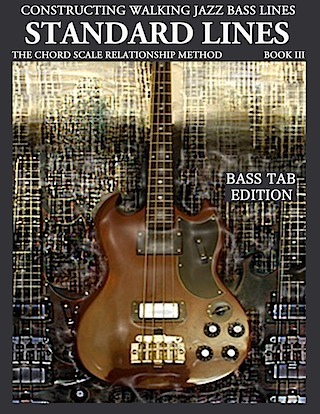
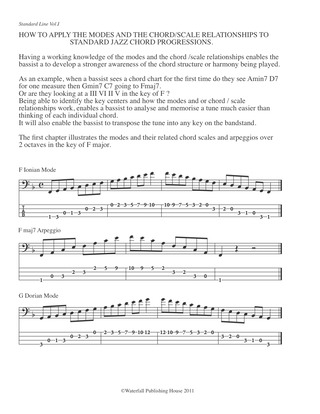
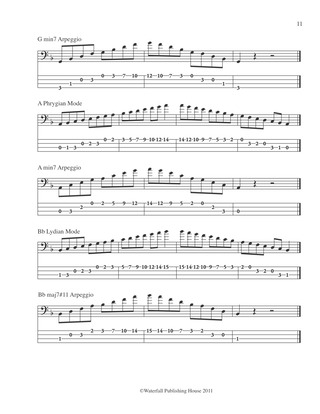
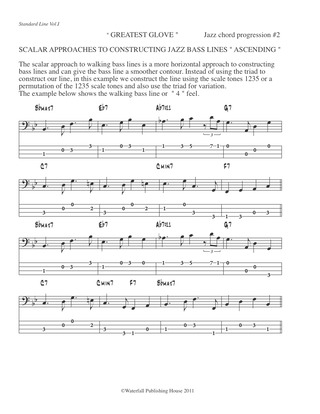
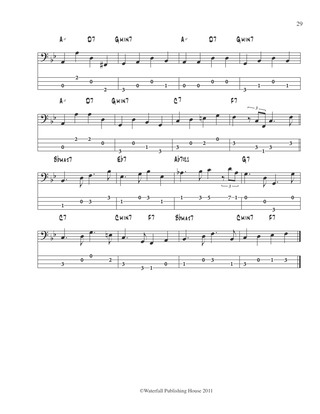
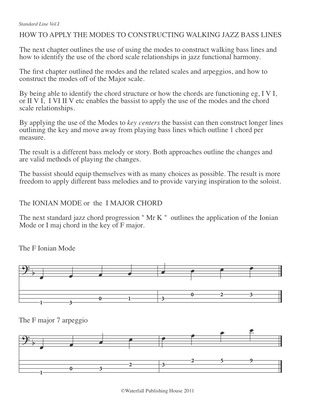
Watch the bass lesson video from the book
Watch bass lesson video II from the book
Constructing Walking Jazz Bass Lines Book I
Bass Tab Edition
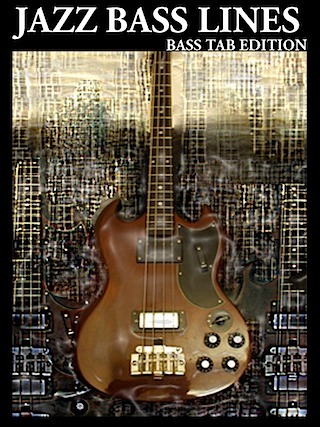

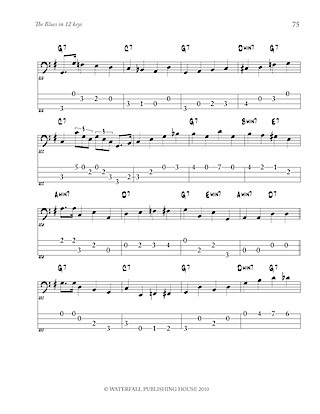
See more bass tab examples from Book I

Watch the lesson video from the book
Constructing Walking Jazz Bass lines Book II
Rhythm changes in 12 keys

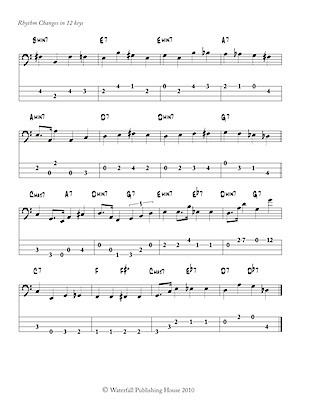
See more bass tab examples from Book II
Readers reviews bass tab and bass clef editions
“looking at the examples, I can tell you that they will be very useful in learning these specifically important Jazz progressions in every key, which practically every Jazz teacher tells me I should do! My music theory training gives me enough insight to recognize that they will be very useful. The appearance and lay-out are comfortable to look-at, which makes it all easier to read; and I like the Jazz fonts! I am particularly pleased that all the examples are completely written-out note-for-note; whereas in many books by other authors, an example will be given in one key with the other keys being left up to the student to figure-out! I always found that to be extremely frustrating
It's nice that you covered so many variations on the basic A part progression of Rhythm Changes, since that's the way the the song really gets played... and to write-out all the bass lines instead of just the chord symbols. This lets the student learn the actual melodic motion of bass lines in the way that they are really used. The use of scale-type phrases, chromatic lines, occasional wide interval leaps, and rhythmic variations (such as quarter-note triplets and dotted-eighth/sixteenth notes) ...all in context... really puts it all in proper perspective. It shows how those devices are actually used! That's the stuff people learn-from through specific examples! Then once the student gets the hang of it, one should be able to call on these ideas in increasingly improvisational and hence musical ways.”
Doug Seattle Washington USA
" bonjour,
i don't find book III .
i've already book one and two , i like it .where i'll buy book III ?"
Lolowes 2002 France
" I should take you a picture of the stack of bass books I have, but I have never been able to retain or understand how lines are constructed, how modes work, etc. The progression of information you are presenting has made very clear what has been a fog to me for years, and I am excited to be opening the door I have been standing in front of since I was a teenager. "
Jon Idaho USA
"I recently purchased Book I , it is the one I wanted. So I
am looking forward to being the Book II will be available.
I understand Book II will be released soon. Since I live in Japan, I hope
Book II will be available on Amazon.co.jp soon. "
Hideo Japan
" I recently purchased book II from amazom.co.jp, and it is also good book for me."
Hideo Japan
5.0 out of 5 stars An invaluable resource to the aspiring jazz bassist,
By
Midwest Book Review (Oregon, WI USA) - See all my reviews
"Constructing Walking Jazz Bass Lines, Book 1, The Blues in 12 Keys: A Comprehensive Guide To Constructing Walking Jazz Bass Lines for the Double Bassist and Electric Jazz Bassist" is a complete 12-key guide to techniques and devices used to construct walking jazz bass lines in the jazz tradition.
Part I, the Blues in F, presents exercises and techniques known to help create robust jazz bass lines, moving forward while retaining a solid rhythmic, harmonic foundation. Part 2, The Blues in 12 Keys, expands further the lessons of Part 1, providing previous techniques and devices used in professional level bass lines in all 12 keys. The practical and ambitious aim of "Constructing Walking Jazz Bass Lines" is "to give the aspiring bassist a solid grounding in understanding how to construct walking Jazz Bass lines and support a melody and or soloist (p. 97)." The Book concludes with sage advice, "Listen to as much music as you can, Listen to the masters (p.97)."
Included is full notations with enharmonic chord symbols for more than 150 choruses of jazz blues lines in all 12 keys, using the whole register of the instrument. "Constructing Walking Jazz Bass Lines Book 1" is an invaluable resource to the aspiring jazz bassist, with potential for learning teaching and great practical application.
|
An Essential Jazz Bassists Book,
This review is from: CONSTRUCTING WALKING JAZZ BASS LINES BOOK I WALKING BASS
LINES: THE BLUES IN 12 KEYS (Paperback)
First of all, the title is a bit of a misnomer. Yes, there are transcriptions of Blues in all twelve keys. The transcriptions are 3 to 5 pages each. But what the beginning to intermediate bassist will find most usefull are the 33 pages, at the beginning of the book, demonstrating the various devices that Jazz Bassists use to construct effective bass lines. The Advanced player will welcome the books interesting exercises to use for keeping the chops up. Steven Moody, the author, guides the reader through exercises including Chromatic Approaches, Dominant 7th Chords, Harmonic anticipation, Voice leading tones, and Tri-Tone Substitution. Mr. Moody's book gives clearly written directions of the various techniques,followed by bass clef progressions that detail the examples. All the examples are interesting and go beyond the usual straight 4 beats to the bar that unfortunately fill up many of the books that I've purchased. I can see that this book will end up as dog-eared and ragged as my copy of Simandl, from repeated use.
|
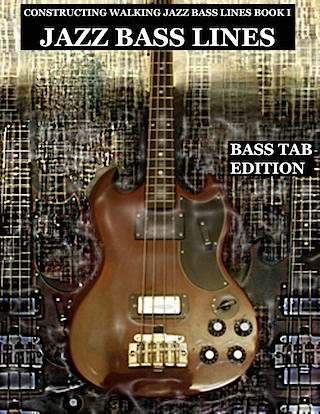
Midwest Book Review - Reviewers Bookwatch December 2010
http://www.midwestbookreview.com/rbw/dec_10.htm#margaret
" a very useful resource "
The home of the Bass Tab versions of " CONSTRUCTING WALKING JAZZ BASS LINES " .
This series of books is designed to suit the electric bassist familiar with reading bass tablature, and provides various topics and musical concepts suitable for the beginning and professional bassist.
I t is the aim of the " CONSTRUCTING WALKING JAZZ BASS LINES " BASS TAB series of books to make available the same knowledge and wealth of information
available to the bassist reading bass tablature, as there would be for the bassist reading bass clef.
The following series of books provides note for note analysis, bass lines and examples as they appear in the standard bass clef volume .
By clicking on one of the book links you can browse the table of contents and find related topics to suit your interests and needs as a bass player.
As an example Vol I. " THE BLUES IN ALL KEYS " has over 150 choruses of bass lines constructed by the author.
The books give examples and lesson topics of specific concepts related to outlining fundamental bass playing , followed by thelesson study material being outlined using a common chord progression or song form with bass lines by the author.
One area of interest for those bass players wanting to learn to read music is the fact that all exercises and bass lines are written out in bass tab with the standard bass clef notation directly above. This enables the bass player to apply what they already know to to the task of learning to read music.


